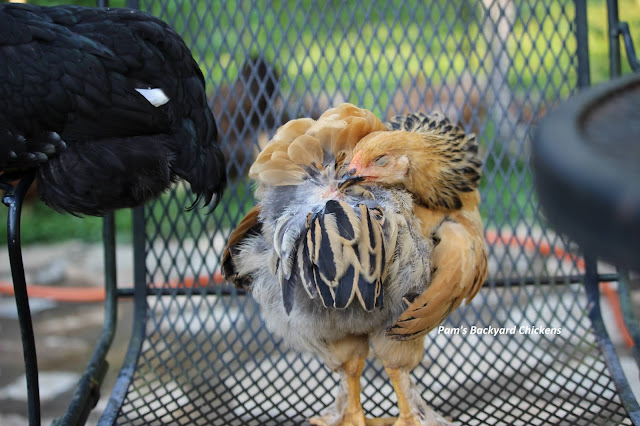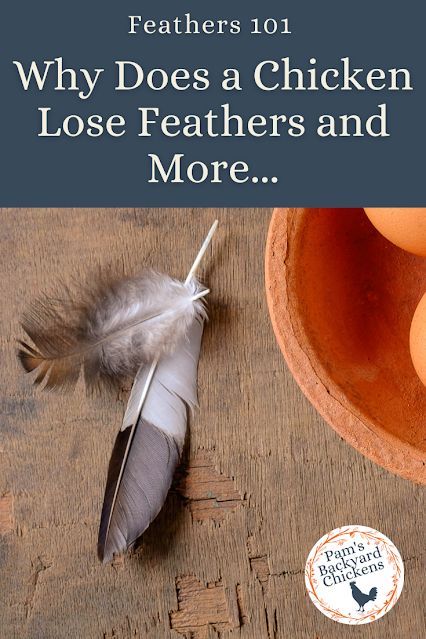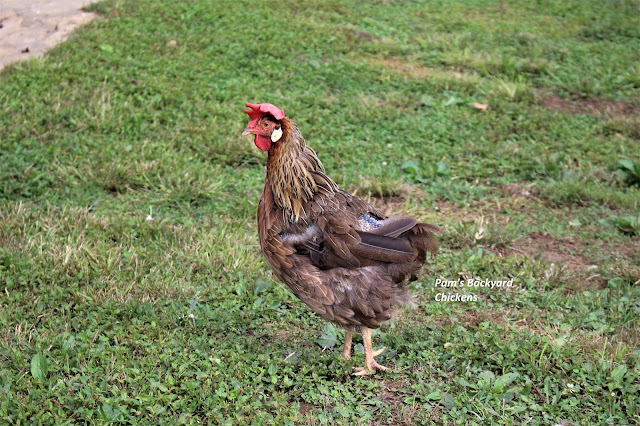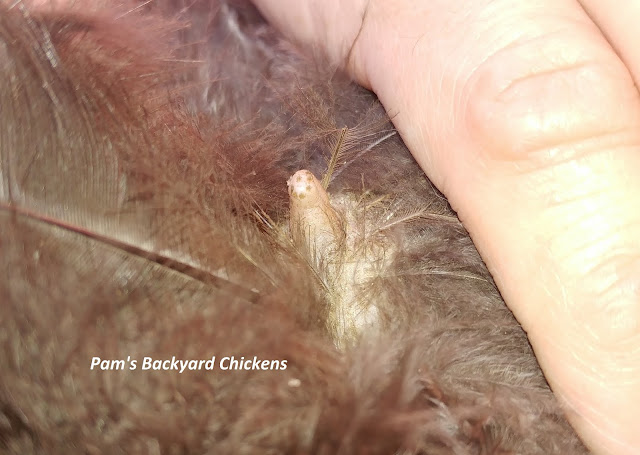Why does a chicken lose feathers? Why are some feathers fluffy and others not? Why do roosters have different feathers than hens? There are so many questions about chicken feathers. Here’s a helpful guide to answer those questions and more…
But what about function? Intuitively we all know some general functions of feathers. You don’t have to go any farther than your local department store to see feathers in action. Down comforters and pillows fetch a high price. Feathered earrings are popular outfit accessories. A down winter jacket is a must-have when temperatures dip. Feathers are all about function. Even their beauty has a purpose.
The overarching function of feathers is to keep a bird protected from cold, hot and wet weather and to protect the skin. But there’s more…
Types of Feathers and their Parts
Chickens have four basic types of feathers — contour, plumules, filoplumes and bristles.
Individual feathers can be broken down into specific parts. The shaft runs the length of the feather with the hollow quill at the end that connects to the body. Barbs come off the main shaft on both sides. Barbs have barbules which have tiny hooks that attach to the barbules of the next barb acting like a zipper that locks the barbs together giving the feather its web. The fluff is at the lower end of a feather with barbs that lack hooks giving it a downy look.
Contour feathers are the first feathers you notice on a chicken. They are the largest of a chicken’s feathers and cover the outside of the bird giving it shape and serving as the first line of defense against the elements.
Plumules are also known as down feathers. They lack the hooks that join barbs together, so they are fluffy rather than smooth. These feathers are most evident on baby chicks, after all, the primary purpose of down feathers is for insulation to trap air for warmth. On adult chickens, down feathers are found closest to the body.
Two smaller feathers filoplume and bristles are less noticeable but still provide function. Filoplumes have a few barbs at the tip giving them a hairlike appearance. Their exact function is not fully understood, but they do have sensory receptors at their base. Bristles are the small feathers around a chicken’s eyes, nose, and mouth. They protect those areas by keeping out dust and debris.
There are two types of chickens with interesting feathers that throw out the book: Frizzles and Silkies.
Frizzle chickens are gaining popularity with backyard chicken keepers because of their interesting look. Frizzle feathers happen because a mutation causes the feathers to twist and turn and stick out randomly all over the body. You can see frizzle feathering in many different chicken breeds.
Silkie chickens have only feathers that lack the ability to zip the barbs together. This means Silkies have no waterproofing so special care should be taken in wet weather.
Daily Feathers
Feathers aren’t top of mind just during molting, they play a role in many daily chicken behaviors as birds spend time each day caring for them.
When birds preen — the act of grooming and cleaning feathers — they can be seen running their beaks along their feathers to zip up loose barbs getting the feather into proper shape and/or biting at their feathers to remove bits of dirt or other substances and parasites.
If you watch carefully, as chickens run their beaks along their feathers, they generally start this behavior by twisting around and dipping their beaks into their tail feathers. There’s a reason for this. The uropygial gland, otherwise known as the preen gland is located near the base of the tail. It’s not noticeable to the naked eye because it’s hidden under dense tail plumage. It looks kind of like a nipple on a baby bottle. When chickens nudge the uropygial gland, it releases an oily, waxy substance that they distribute over their feathers to keep the feathers supple and to help repel dirt and water.
Although chickens don’t bathe in water, they do bathe in dust and sun.
Dustbathing is a way for chickens to remove excess oil and parasites. Free-range chickens will find a dry patch of dirt and dig their own dust baths. If chickens are confined, they need to be provided a dust bath. Chickens luxuriate in a dust bath moving to get the best angles as they scratch dirt deep into their feathers. Dust bathing chickens are a glorious sight to behold, but beware of standing too close to chickens after they leave a dust bath because they shake all that dirt and dust off and it goes everywhere!
Sunbathing chickens can be found on even the hottest day of the year sprawled on the ground often with one or both of their wings extended. Chickens get so absorbed in their sunbathing that they can appear dead at first glance. But they’re not! Sunbathing serves many purposes and plays a big role in feather health. Generally, it helps to destroy bacteria, convert compounds in the oil from the uropygial gland into vitamin D, allows for warmth in cold weather and drying if the bird gets wet. For feather health, it allows easier access to parasites for their removal. As chickens sunbathe, they will strategically expose body parts to the sun making it uncomfortable for parasites. As the parasites move to get cooler, the chicken will preen to remove them.
Looking Good
In case you’re wondering about the function of beauty, yes, beautiful feathers are a big deal in the chicken world too. While beauty is touted in humans as being only skin deep, in the chicken world, outward beauty shows a lot about the inner bird.
A healthy bird has feathers that are clean and well-groomed. A healthy bird’s feathers are at their best providing protection, insulation, the ability to fly and the ability to attract a mate.
Speaking of attracting mates, rooster feathers have beauty for that purpose. Their showy tail and neck feathers attract a hen’s attention. On the other hand, hen feathers are designed more for camouflage as she has to sit on a nest and raise her brood, during which time, it’s better to stay unnoticed by predators.
For chicken keepers, feather condition can be a good indication of their bird’s health. It’s good to check birds often so problems can be detected early. Plumage quality can start to decline noticeably if a bird is infested with parasites like lice and mites. Bare patches of skin on a hen’s back can mean she is being overmated. Bare patches of skin can also indicate feather picking or eating — often a sign of bullying or that birds are too hot, bored or overcrowded.
Be careful not to jump to conclusions too quickly though. Bad-looking feathers can be a sign of an active bird or one that’s getting ready to molt. On a personal note, I have a New Hampshire hen whose feathers always look terrible. One, she does draw the attention of our rooster more than others. But also, she’s an active free-range bird that always seems to find places to damage her feathers. She’s healthy as a horse but looks a little worse for the wear.
Feather Identification
It’s good to know how to identify the feathers you can see at a glance when looking at a chicken. By using the correct terms, you can better understand your chicken and describe it when needed.
Hackles: These feathers essentially form a ring around the neck including the rear and side feathers. Both hens and roosters have hackle feathers, but the rooster’s hackle feathers are more prominent being long and pointed.
Saddle: The saddle is located along the rear of the back where it meets the tail. A rooster’s saddle area is covered with long pointed feathers.
Tail Coverts: These feathers cover the base of the main tail feathers in roosters and most of the tail in hens. A rooster’s tail coverts are long and showy.
Sickles: The main sickles are the two long curving feathers at the top of a rooster’s tail. Lesser sickles hang to the side and cover the main tail.
Main Tail Feathers: These are the long, straight and stiff feathers of the tail. They are more prominent on a hen but covered in both sexes by the tail coverts and sickles in the case of a rooster.








No comments:
Post a Comment